It doesn’t take much to raise the ire of the internet, so it’s no wonder that what recently got netizens furiously typing was the alleged pervasiveness of a dead-eyed gaze called the Gen-Z stare. Thanks to viral memes and trend coverage in far-reaching media outlets like NBC News, Business Insider, and The New York Times, the Gen-Z stare has grown from a niche online discussion to a topic worthy of its own Wikipedia page. Why should marketers care? Should marketers care? We used our social listening and analytics solution to find out.
What is the Gen-Z stare?
The phrase “Gen-Z stare” describes a supposedly apathetic or blank look attributed to members of Gen Z interacting with people older than them in social situations. Often evoked about subpar customer service interactions, it is generally seen as a sign of apathy, social awkwardness, judgment, or dismissal. For a visual, check out this Instagram video created by two influencers, which racked up over 477,000 likes in just seven days.
In short, the Gen-Z stare is the latest generational debate about social norms and who gets to decide them. For marketers, it offers an opportunity to learn more about how cultural discourse evolves as it spreads across digital spaces.
What can marketers learn from the viral Gen-Z stare conversation?
The Gen-Z stare has been an active point of cultural discourse online and in the media. For marketers, it illustrates how discourse and microtrends evolve as they spread across today’s sea of digital channels. Overall, from July 1 to August 4, 2025, there were about 70,300 mentions of the phenomenon across more than two dozen sources, including news, broadcast, comments, forums, and social media platforms, including X, Reddit, Bluesky, and YouTube.
Initially, short videos about the trend began to go viral in June then quickly spread across social platforms. Of the ones we analyzed, the buzz about Gen-Z stares peaked on Reddit on July 14, four days before it peaked on X, which has a much larger user base. This progression is the opposite of some of the other trends we’ve analyzed, like the Walmart Birkin viral moment from earlier this year. Highly engaged posts about Gen-Z stares on Reddit focused on critique of how Zoomers act in their workplaces and their failures to deliver adequate customer service, as well as debate on whether the phenomenon is real at all. Mentions of the Gen-Z stare later spiked on broadcast media on July 17 as news and radio personalities across the U.S. and Australia gave their own takes on the new internet hot topic.
It was only after the conversation peaked in broadcast that it spiked on X, where highly engaged posts instead skewered the idea of the Gen-Z stare, pointing to baby boomers as the true perpetrators of social awkwardness. For example, one viral post on July 18 proposed the idea of the “boomer inappropriate personal question.” About two weeks later, X mentions of the Gen-Z stare peaked again on August 2, with a new round of users sharing punchlines and jokes about bad personal experiences as service industry workers engaging with customers older than them.
This post on X helped drive a 19x spike in mentions of the Gen-Z stare on social media on July 18, 2025.
What began as a discussion rooted in Millennial and older generations’ perspectives on social norms shifted to a Gen-Z driven backlash focused on the rudeness young people face from older people in their personal lives and at their public-facing jobs. For marketers, this evolution is a case study in how smaller social platforms can be launchpads for trends that reverberate on larger ones, crossing generational lines in the process. And more simply, the uproar over the Gen-Z stare, like the Millennial cringe and “Millennials are killing” discourse that came before it, shows that generational anxieties and accusations are always guaranteed lightning rods for discussion.
Marketing takeaways from the viral Gen-Z stare moment
- To stay ahead of cultural discourse and trends, brands need to monitor more than just the big three social platforms. Niche platforms, particularly forum-based ones that allow for deeper discussion, are where online discussions and perspectives can brew and grow. Broadcast and news can amplify those conversations that then find new life on the battleground of X.
- Conversational tones and perspectives can flip fast, as shown by the Gen-Z stare discourse’s tonal evolution from Reddit to X. Not every viral discussion is advisable for brands to jump onto, particularly if they involve sensitive overgeneralizations. However, marketers can and should use these moments to observe, learn, and dig into central truths behind all the hubbub.
- The digital ecosystem is highly interconnected and overlapping. For example, according to our July Global Statshot, 25.3% of X users also use Reddit, while 64.4% of Reddit users also use X. What happens in one digital space reverberates to others as news media covers what people are talking about online, which then provides more fuel for online discussion and so on. Taking a multi-faceted approach to market and audience understanding is crucial for creating content and strategies that are context-aware and adaptable.
